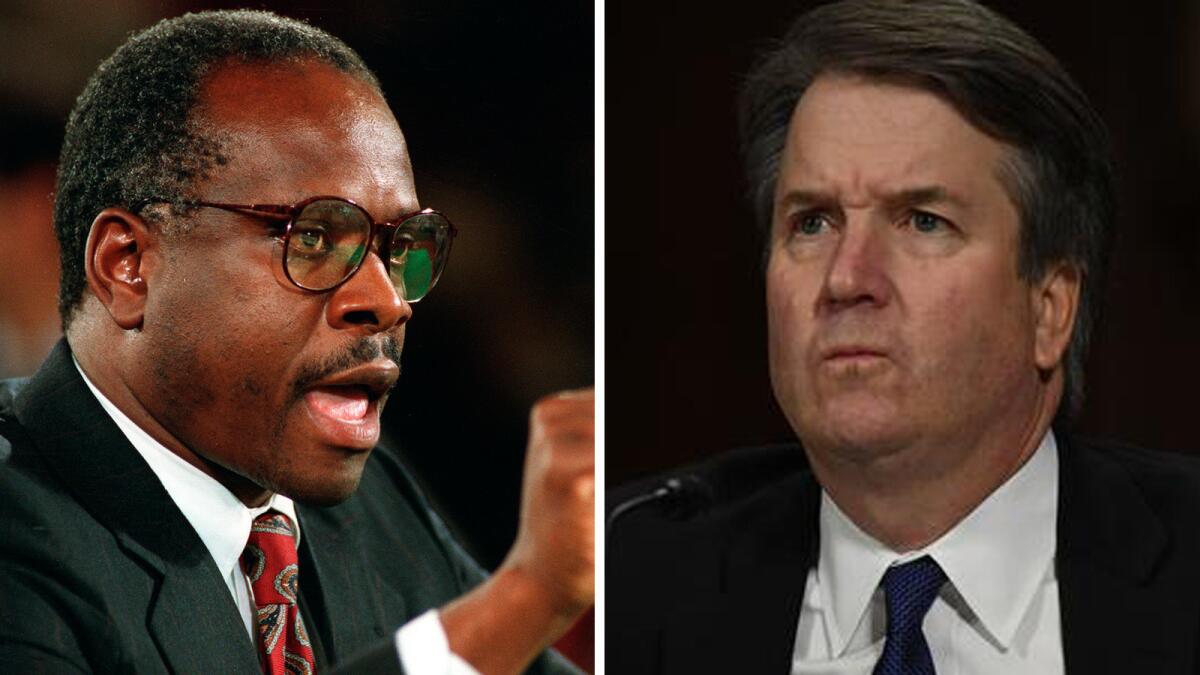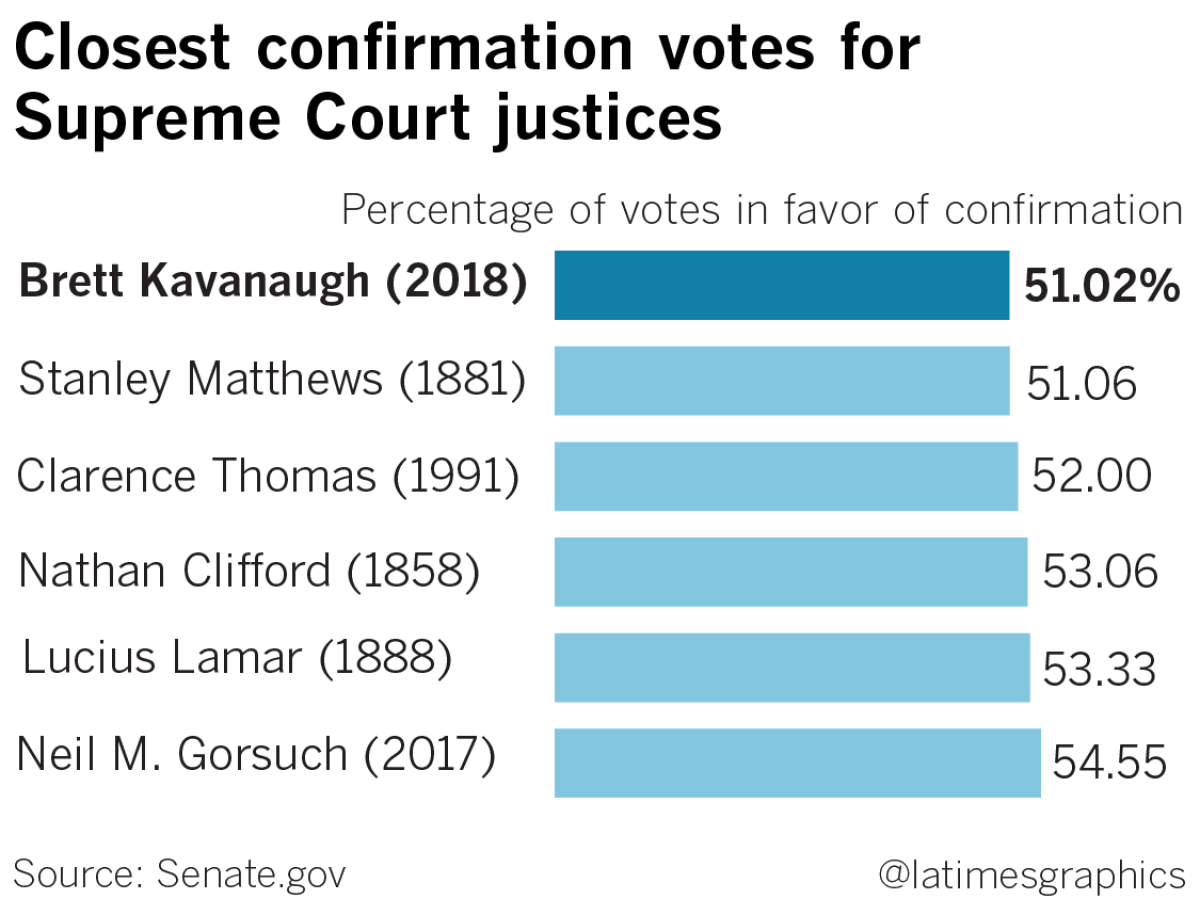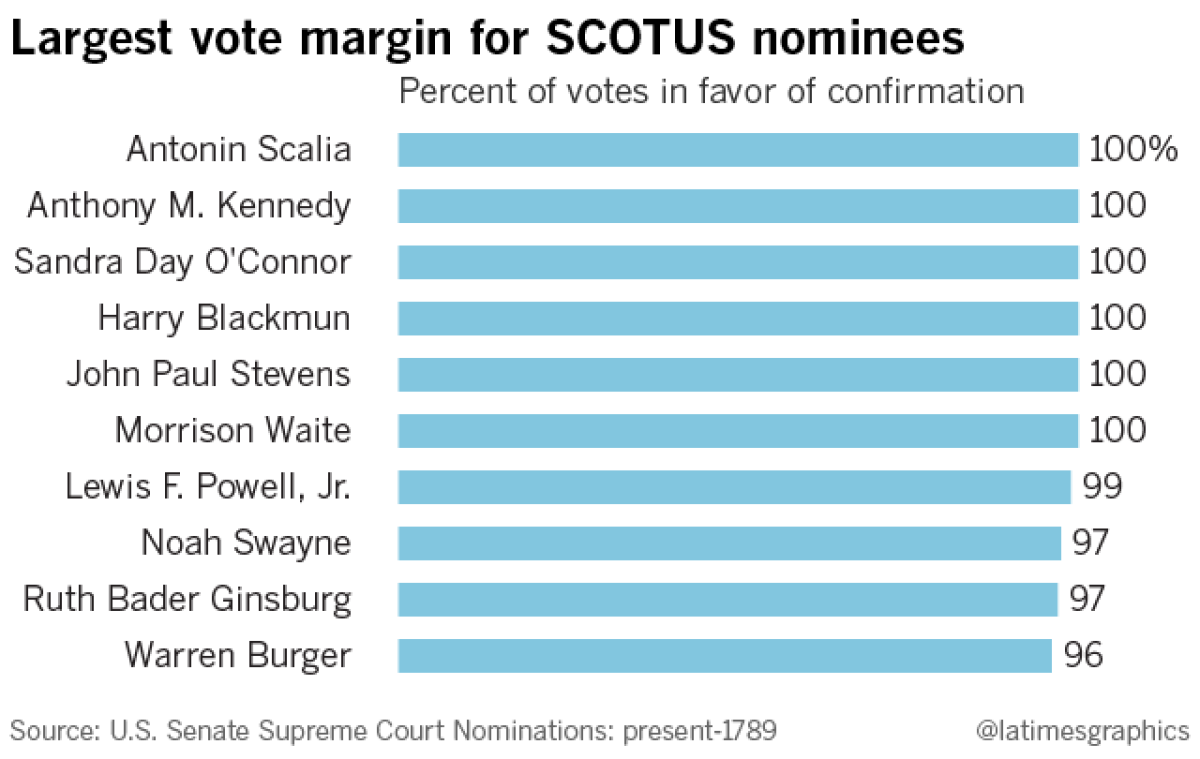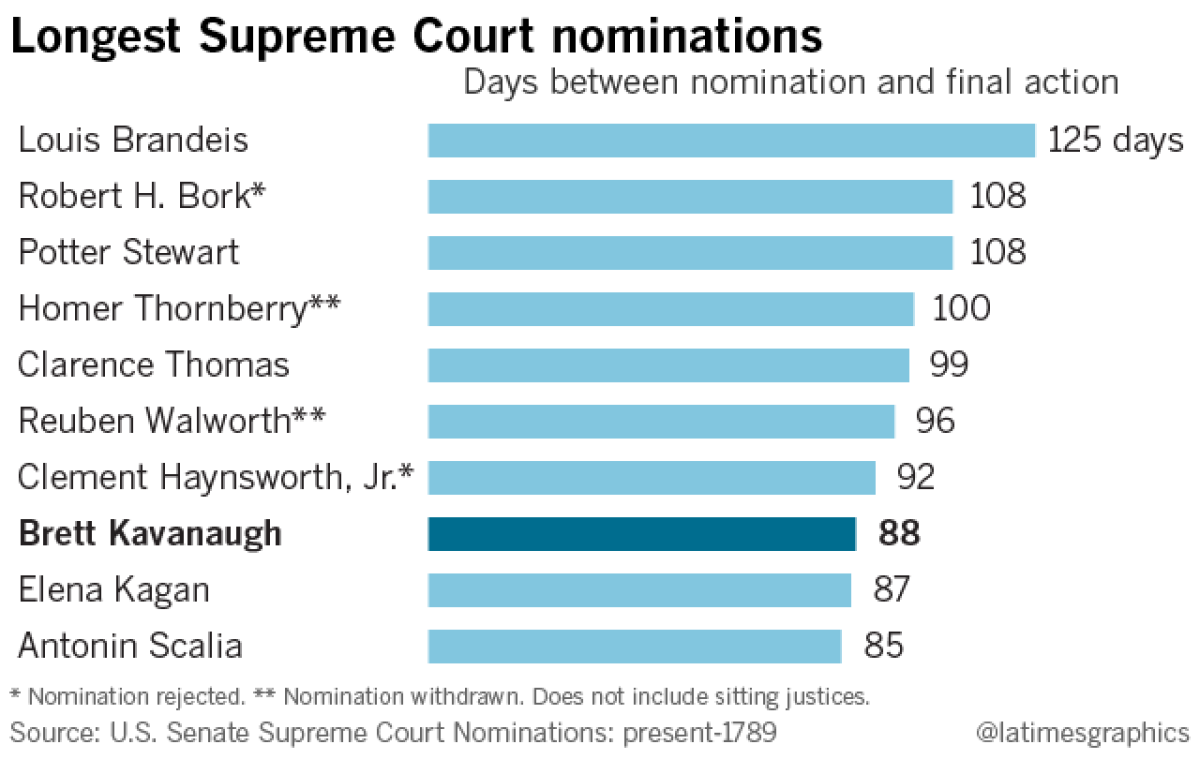Senate vote on Kavanaugh was historically close

- Share via
The Senate on Saturday approved Brett Kavanaugh to the Supreme Court with a 50-48-1 vote, the narrowest margin for a confirmation vote in more than 130 years.
In 1881, Stanley Matthews, President James Garfield’s pick to replace Justice Noah Swayne, won confirmation by a single vote, 24 to 23 (51.06%).
Since then, the next closest came on Oct. 16, 1991, when Clarence Thomas won confirmation 52 to 48.
Kavanaugh's vote of 50-48-1 was 51.02%. Sen. Steve Daines (R-Mont.) was attending his daughter's wedding Saturday, and with Kavanaugh having enough other votes to win confirmation, Daines did not return to Washington for the vote. Sen. Lisa Murkowski (R-Alaska), who had planned to vote against Kavanaugh, instead voted “present” as a courtesy to Daines.

Close votes that ultimately confirm a Supreme Court nominee are rare. More often, nominees have been confirmed by wide margins.
Two-thirds of successful nominees were confirmed by at least 75% of the Senate, excluding those confirmed by a voice vote.
And 10 nominees have received at least 96% of the vote.

As the country — and the Senate — has become more sharply divided along partisan lines, the divide in Supreme Court confirmations has become more stark.
The tightening began with the 2005 confirmation ofSamuel A. Alito Jr., a George W. Bush nominee.
The vote became closer with the confirmation of Neil M. Gorsuch, President Trump’s first nominee. The Democrats used a filibuster to oppose the nomination and keep Gorsuch from receiving 60 votes required to advance. The Republican-controlled Senate then removed the filibuster for future Supreme Court nominees.
Of the 18 Supreme Court nominations since 1980, four were made by Democratic presidents while Democrats also held the majority in the Senate. Republican presidents nominated eight people to the Supreme Court while the GOP held the majority in the Senate.
Most of the big battles have come with the nominations in which the president and the Senate majority were of different parties: The defeated nomination of Judge Robert H. Bork in 1987, followed by the nomination and withdrawal of Judge Douglas Ginsburg; the Thomas vote in 1991; the Senate’s refusal to consider President Obama’s nomination of Judge Merrick Garland.
The other two nominations made with the president and Senate in different parties went more smoothly — George H.W. Bush’s nomination of David H. Souter and Reagan’s nomination of Anthony M. Kennedy, the man Kavanaugh has been nominated to replace.
Supreme Court nominees since 1980
The U.S. Senate has considered 18 Supreme Court nominees since 1980.
| Nominee | Presidential party | Senate majority party | Percent of votes in favor of confirmation |
|---|---|---|---|
| NomineeBrett Kavanaugh | Presidential partyRepublican | Senate majority partyRepublican | Percent of votes in favor of confirmation51.02% |
| NomineeNeil M. Gorsuch | Presidential partyRepublican | Senate majority partyRepublican | Percent of votes in favor of confirmation54.5% |
| NomineeMerrick B. Garland | Presidential partyDemocrat | Senate majority partyRepublican | Percent of votes in favor of confirmationNo vote held |
| NomineeElena Kagan | Presidential partyDemocrat | Senate majority partyDemocrat | Percent of votes in favor of confirmation63.0% |
| NomineeSonia Sotomayor | Presidential partyDemocrat | Senate majority partyDemocrat | Percent of votes in favor of confirmation68.7% |
| NomineeSamuel A. Alito Jr. | Presidential partyRepublican | Senate majority partyRepublican | Percent of votes in favor of confirmation58.0% |
| NomineeHarriet Miers | Presidential partyRepublican | Senate majority partyRepublican | Percent of votes in favor of confirmationNomination withdrawn |
| NomineeJohn G. Roberts Jr.* | Presidential partyRepublican | Senate majority partyRepublican | Percent of votes in favor of confirmation78.0% |
| NomineeStephen G. Breyer | Presidential partyDemocrat | Senate majority partyDemocrat | Percent of votes in favor of confirmation90.6% |
| NomineeRuth Bader Ginsburg | Presidential partyDemocrat | Senate majority partyDemocrat | Percent of votes in favor of confirmation97.0% |
| NomineeClarence Thomas | Presidential partyRepublican | Senate majority partyDemocrat | Percent of votes in favor of confirmation52.0% |
| NomineeDavid H. Souter | Presidential partyRepublican | Senate majority partyDemocrat | Percent of votes in favor of confirmation90.9% |
| NomineeAnthony M. Kennedy | Presidential partyRepublican | Senate majority partyDemocrat | Percent of votes in favor of confirmation100.0% |
| NomineeDouglas H. Ginsburg | Presidential partyRepublican | Senate majority partyDemocrat | Percent of votes in favor of confirmationNomination withdrawn |
| NomineeRobert H. Bork** | Presidential partyRepublican | Senate majority partyDemocrat | Percent of votes in favor of confirmation42.0% |
| NomineeAntonin Scalia | Presidential partyRepublican | Senate majority partyRepublican | Percent of votes in favor of confirmation100.0% |
| NomineeWilliam H. Rehnquist*** | Presidential partyRepublican | Senate majority partyRepublican | Percent of votes in favor of confirmation66.3% |
| NomineeSandra Day O'Connor | Presidential partyRepublican | Senate majority partyRepublican | Percent of votes in favor of confirmation100.0% |
* Initially nominated for associate justice, resubmitted for chief justice
** Rejected by U.S. Senate
*** Sitting justice nominated to chief justice
Source: U.S. Senate Supreme Court Nominations: present-1789
The Kavanaugh confirmation process was one of the longest of the 189 nominees to the Supreme Court dating back to 1789. Kavanaugh’s confirmation process lasted 88 days, which is the eighth-longest and the longest since Reagan nominated sitting Justice William H. Rehnquist to replace Warren Burger as chief justice in 1986.

UPDATES:
5:35 p.m.: This article was updated to note that Kavanaugh won 51.02% of yes-or-no votes cast.
2:05 p.m.: This article was updated with details on Kavanaugh’s confirmation.
1:28 p.m., Oct. 6: A graphic in this article was updated to reflect the confirmation of Brett Kavanaugh was the narrowest margin in modern history.
This article was originally published at 6:54 p.m. on Oct. 5.
Sign up for Essential California
The most important California stories and recommendations in your inbox every morning.
You may occasionally receive promotional content from the Los Angeles Times.








